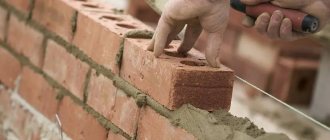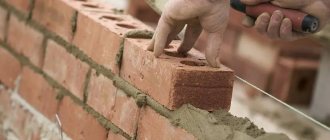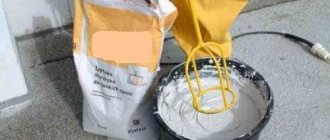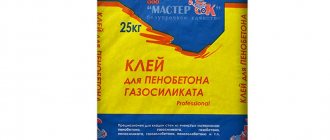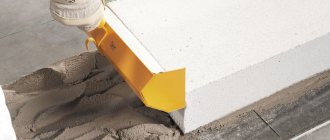Mortar consumption per 1m3 of brickwork
Approximate consumption of mortar per 1 m2 of masonry
Most builders calculate approximately the consumption of mortar per 1 m2 of masonry, but there are certain subtleties that are very important to take into account. So, the consumption rates of the solution per 1 m3 of masonry can be different, and this is what will be discussed further
A little about brickwork
As you know, the use of bricks in construction is an extremely common phenomenon. Buildings made from this material are characterized by high reliability, they retain heat well and transmit much less noise compared to structures made from some other materials.
Factors affecting the cost of cement mixture
What affects solution consumption
The criteria on which the volume of mortar consumption per 1 m2 of masonry depends are as follows:
- The thickness of the walls of the structure, which can be 1, 1.5 and 2 bricks.
- The type of cement used for the anchoring base.
- A type of building material used, which can be either solid or hollow from the inside.
Principle of production of building fastening material:
Depending on exactly what components are included in it (sometimes structures such as clay, lime are used), the consumption of the solution per m3 of masonry may be different.
Professional skills of someone who mixes cement ready for installation:
- It is believed that there is nothing complicated in such work and even an inexperienced owner can do it with his own hands.
- However, a very common reason for overspending is that, due to his inexperience, the master uses more material than the instructions require.
Based on what type of cement is used in the fixing composition, some conclusions can also be drawn.
How much dry raw material is required for 1 m3 of building mixture?
Each type of cement has its own measures.
So, studying the consumption rates of mortar for laying partitions of ¼ brick, dry raw materials are used in the following quantities:
- Cement grade “M50” – 2.5 kg.
- Mixtures of type “M75” require 4 kg.
- For cement grade “M100” you need to use 5 kg.
There are some other ways to perform measurements:
- If the installation is carried out in 1 brick, then the mortar consumption per 1 m/sq. m of masonry will be approximately 75 liters.
- When constructing partitions with 1.5 elements, this parameter will change and will be equal to 110 l.
Amount of cement per cubic meter
Required amount of cement to prepare 1 m3 of building composition:
- Professional specialists use such measures very often, since volume is the basis of all calculations.
- It is believed that in order to prepare 1 m3 of the composition, at least 400 kg of cement will be required (in other words, standard 50 kg bags).
- At the same time, the consumption of masonry mortar per 1 m3 of masonry will be about 0.25 m3 of the resulting composition.
- It is these proportions that are taken as optimal and used in construction.
Expense rate
Despite this, the data in certain sources may differ slightly, which may be due to the presence of different installation options.
The previously indicated rate of mortar consumption per cube of masonry is suitable for the standard installation procedure and can be taken into account when independently constructing a brick building.
During long-term storage, the technical characteristics of the material are significantly reduced, and the price of such an error is very high:
For example, the “M400” cement brand, after six months of its acquisition, will correspond in its properties to the “M200” or “M100” brand.
Tools used to calculate train costs
When calculating the cost of cement mixture consumption for brick installation, you need to take into account the list of tools required for this procedure.
These include:
The use of cement composition when installing shell rock
First of all, it should be noted that the consistency of the fixing structure for installing shell rock must have certain viscosity parameters.
Calculation of how much mixture is needed per 1 m3
Intuitively, every person should understand that the consumption of the presented mixture will depend on the strength of the structure that will be erected. For example, to build a foundation you need M300 concrete and no lower, but for a screed, a solution with a strength of 150 kg/cm2 is quite suitable. Each brand of mixture has its own properties and scope of application.
The higher it is, the less material is needed. Knowing the consumption of the mixture per meter cubed is very important, because in this way you can purchase the exact amount of material and not worry that you will need to bribe it. In addition, when purchasing, you can even purchase material in a larger volume, since its consumption is greatly influenced by the type of structure being built. It will also be interesting to read about how many bricks are in 1 m3 of masonry.
Plastering walls
When performing such work, a classic plaster mortar is most often used. It contains components such as sand, cement, taken in a ratio of 1:3.
When leveling the surface, material consumption will be directly related to the thickness of the applied layer. If this parameter does not exceed 12 mm, then for 1 m3 of plaster you will need to stock up on 1.6 kg of M40 mixture or 1.4 kg of M500 mixture. The volume of solution per m2 is easy to calculate. To do this, we use the above formula: 1m2x0.012 m = 0.012 m2 or 12 liters.
Here you can see photos of the base panels.
Wall masonry
When laying a brick wall, it is very important to ensure its strength. In this case, it is necessary to take into account not only the quality and strength characteristics of the brick, but also the mortar that will be used in this case. If you decide to buy a ready-made composition for masonry, then you need to take into account that to build 1 m3 of wall in 1 brick, you need to use 75 liters of M100 mortar.
Types of solutions and their applicability
The connecting link between brick blocks is a mixture of the binder component with filler and water. The most common are 4 types of solutions.
- Cement-sand. It is diluted with water, its proportions depend on the brand of cement and the method of laying. When hardened, this option is the most durable, but if the technology is deviated from, it is prone to cracking;
- Limestone - in it cement is replaced with quicklime; it is plastic, but is washed out by rain, so it is only suitable for installing internal walls;
- Mixed - cement and sand are diluted with liquid slaked lime (lime milk). The combination combines the best qualities of the first two options;
- With a plasticizer - a polymer additive is mixed with cement and sand (fraction 2 mm) to increase the plasticity of the mixture. It is easier to make such a solution from a dry construction mixture by adding water according to the manufacturer’s instructions.
Despite the composition, the requirements for the quality of the mixture are almost the same. All ingredients are cleared of lumps, the sand is sifted, and the liquid lime is filtered. To prepare the solution, first thoroughly mix the powder components, then slowly pour in cold liquid (20 o C) and mix thoroughly so that setting does not occur. The process is accelerated using a concrete mixer or a hammer drill with a whisk attachment.
Mortar consumption per cube of brickwork
How long does it take to prepare mortar for laying a wall? This is determined by several conditions:
- the skill of a mason;
- the structure of the brick block - products with voids take more mortar mixture;
- type of brick - hyper-pressed and facing silicate absorbs less mortar than ceramic or ordinary silicate with a rough surface;
- wall thickness.
The average consumption of mortar per 1 m3 of brickwork with a standard joint thickness (12 mm) is approximately 0.23 m3. Table 1 provides more accurate information.
Cement consumption for bricklaying
The composition of the mixture for constructing a brick wall varies depending on the quality of the original components, weather conditions, and the number of storeys of the building. To mix the ingredients correctly, you should know: a 10-liter bucket holds 14 kg of cement or 12 kg of sand.
- Cement mortar is flexible in proportions. It is characterized by the degree of strength: the lower it is, the lower the required grade of cement and the lower its percentage (1 part to 2.5 - 6 parts of sand). For M400 cement the ratio is 1.3, for M500 – 1.4. The volume of water (on average 0.5 - 0.7 liters per 1 kg of cement) depends on the desired thickness of the mixture, the type of brick, air temperature - in the summer heat the solution should be more liquid. To increase its plasticity, experienced masons add a little washing powder or dishwashing detergent to the water. For 1 cubic meter of ready-made mortar 1.4, 410 kg of M500 cement and 1.14 m3 of sand are needed. Knowing that for 1 cubic meter of an ordinary wall, one brick made of a silicate block 250 x 120 x 65 takes 0.24 m3 of mortar, the cement consumption per cubic meter of brickwork is determined as follows: 0.24 x 410 = 98 kg. Accordingly, when using M400 cement (proportion 1.3) a cubic meter of the mixture contains 490 kg of cement, and 117 kg of it is consumed per 1 m3 of masonry.
- Cement-lime mortar is suitable for use within 5 hours, and in the summer at +25 o - no more than an hour, so calculation is also desirable for it. For 1 cubic meter of mixture, 190 kg of cement M400 - M500, 1.5 m3 of sand, 106 kg of hydrated lime and 475 liters of water are required. For a cubic meter of masonry you will need an average of 46 kg of cement.
Consumption of cement for laying bricks during cladding
In this case, the developer is interested in how much binder mixture will be consumed per square meter of wall. This depends on the water absorption of the building material, the season of work, the hollowness and porosity of the blocks. The standards are laid down in SNiP 82-02-95, but the real numbers are always higher, so you should buy ready-made mortar or cement with a reserve.
To save on consumables, 2 factors should be noted:
- the larger the dimensions of the brick, the less mortar will be needed;
- The higher the % of voids and pores, the higher the mixture consumption will be.
From this point of view, it is optimal to use ceramic or silicate double bricks of sufficient strength. This choice will allow you to achieve savings of 20% of the mortar mixture. Table 2 shows comparative data on mortar consumption per square meter of wall.
Mixture consumption
The consumption of mortar for brickwork depends on the type of construction site and mixture. Most often, the average consumption value per 1 m2 is accepted, which is 0.2-0.25 m³. This mixture consumption is typical for laying single or one-and-a-half bricks. One square meter of area requires about 75 liters of mixture.
To determine the consumption of mortar per 1 m3 of masonry, a table is provided and the average value of consumption of CPS is given. If the wall thickness is 120 mm and the installation is carried out with a single brick, then about 30 kg of the mixture will be required, one and a half - 24 kg, double - 18 kg. If the thickness is 250 mm, then for a single brick you will need 78 kg, for a one-and-a-half brick - 66 kg, for a double brick - 54 kg. If the thickness of the structure (wall) is 380 mm, then the consumption when laying with a single brick will increase to 126 kg, one-and-a-half - up to 108 kg, double - up to 90 kg. If you purchase the dry mixture in accordance with these rules, then a small supply will be formed, because Values are rounded up.
The mortar consumption per cube of masonry is about 0.221 m³ for a single brick and 0.234 m³ for a one and a half brick. Professional builders recommend calculating material consumption equal to 0.25 m³. This will make it possible to make the joints more even and to build a high-quality brick wall with excellent strength properties.
When purchasing dry mixtures for bricklaying, you need to pay attention to the approximate consumption per 1 m2 of bricklaying. It is indicated on the packaging. After this, you should refer to the above standards and compare these values. This proportion will allow you to select the required amount of building material and reduce the number of costs for purchasing extra packaging. The consumption of the dry mixture approximately corresponds to that of a self-prepared composition.
The consumption of mortar for laying bricks (hollow) increases significantly, which is due to the presence of voids filled with the mixture. For one-and-a-half bricks, the mortar consumption rate per 1 m3 of masonry is 0.23 m³. High-density masonry mixtures do not penetrate such voids well, which reduces the quality of the finished structure. However, high mobility of the composition can also lead to a decrease in the strength of the mortar and the wall as a whole.
What compounds are used
The most famous and popular mixtures:
- Traditional universal building composition of sand and Portland cement. The standard ratio of components is three to one or four to one;
- A working mixture of sand and quicklime. Applicable only for interior masonry work;
- Mixed composition for brickwork. These are quartz sand, cement and slaked lime;
- Cement mixtures with plasticizer additives.
General standards according to SNiP II-22–81: sand must be washed and sifted, milk of lime must be strained, cement must be fresh and without lumps. All compositions are mixed with clean technical water. Water is added to the dry mixed ingredients in portions until the required consistency is achieved.
Cost of solution per cubic meter of partition
The solution consumption rates per 1 m3 are affected by the following process parameters:
- Base thickness and quality of brick blocks;
- A type of brick - it can be solid or hollow;
- Climatic conditions - air temperature and humidity, sunny or cloudy day.
Practice shows that for a 1m2 building made of ordinary brick, 75 liters must be prepared. A structure of one and a half bricks will require the preparation of 115 liters of working mixture, a base of half a brick will take 40 liters of cement composition per 1 m2.
According to SNiP 82-02-95, which show that the mortar consumption rates per 1 m3 of brickwork are as follows:
- 0.19 cubic meters for half-brick masonry;
- 0.22 cubic meters for laying one brick;
- 0.235 cubic meters for masonry in one and a half blocks;
- 0.24 cubic meters for laying two bricks;
- 0.25 cubic meters for masonry in two and a half blocks.
More accurate and expanded data is contained in SNiP II-22–81.
Wall mortar - how much is needed per 1 m2
How to find out the consumption of mortar per 1 m2 of brickwork? To avoid doing the calculations, there is a table of all the components included.
It takes into account the consumption of mortar for laying bricks from different materials:
| Variety | Compound | Proportions of components for the layer | ||
| Spray | Priming | Covering | ||
| Slaked or quicklime | Lime milk and quartz sand | 1,0:(2,5-4,0) | 1,0:(2,0-3,0) | 1:(1,0-2,0) |
| Portland cement | Portland cement and quartz sand | 1,0:(2,5-4,5) | 1,0:(2,0-3,5) | 1,0:(1,0-1,5) |
| Clay | Quartz sand and clay | 1,0:(3,0-5,5) | 1,0:(3,0-5,5) | 1,0:(3,0-5,5) |
| Lime-cement | Portland cement, lime milk and quartz sand | 1,0:(0,3-0,5): (3,0-5,0) | 1,0: (0,7-1,0): (2,5-4,5) | 1,0:(1,0-1,5):(1,5-2,5) |
| Gypsum-lime | Lime milk, gypsum and quartz sand | 1,0:(0,3-1,0): (2,0-3,5) | 1,0:(0,5-1,5):(1,5-2,5) | 1,0:(1,0-1,5): (1,5-2,5) |
| Clay-lime | Lime milk, clay and quartz sand | 0,2-1,0:(3,0-5,0) | 0,2-1,0:(3,0-5,0) | 0,2-1,0:(3,0-5,0) |
| Clay-cement | Portland cement, clay and quartz sand | 1,0:4,0:12,0 | 1,0:4,0:12,0 | 1,0:4,0:12,0 |
Consumption rates for building mixtures for different types of building blocks
About 0.0108 m3 of composition is consumed per unit, and 0.054 m3 of mixture will be needed to cover 50% of the seam. The arithmetic mean of these two values is 0.08 m3. This value determines the consumption of mortar per 1 m2 of brickwork.
For different masonry this parameter will be equal to:
- When erecting a half-brick partition - 0.04 m3;
- Private - 0.82 m3;
- One and a half - 0.125 m3;
- Double - 0.164 m3.
The table shows the mortar consumption rates for brickwork made from blocks of different sizes for partitions of different thicknesses:
| Type of work | Scope of construction work | Volume |
| Masonry work | 1 m2 with a base thickness of a quarter of a briquette | 14 liters |
| 1 m2 with a base thickness of half a brick | 35 liters | |
| 1 m2 with a thickness of one brick | 75 liters | |
| 1 m2 with a wall thickness of one and a half bricks | 115 liters | |
| Plastering | 1 m2 of mantel without grouting using fine gravel | 13 liters |
| 1 m2 of plaster of internal surfaces | 17 liters |
In this case, the solution consumption per 1 m3 will be equal to:
- When working in half a brick for 53 building units - 0.19 m3;
- For single masonry for 102 blocks - 0.22 m3;
- One and a half for 153 units - 0.23 m3;
- Double for 204 blocks - 0.24 m3.
How to calculate the amount of bricks to build a house?
To calculate the required amount of brick, you need to know the area of the future walls and the method of laying them.
For maximum reliability and solidity, during construction, bricks are laid in a bandage.
And if for interior partitions simple methods of ligation with displacement are used (this can be ligation of half a brick or one), then load-bearing walls (both external and those that take on the weight of floors and roofs) are performed in several ways:
- one and a half bricks when the wall thickness is 38 cm including seams;
- in two bricks, the wall and seams will have a thickness of 51 cm;
- two and a half bricks, this option assumes a 64-centimeter wall.
Based on these data, we can conclude that the volume of material required for the construction of each wall is different in each specific case. The formula for calculating it is simple. You need to multiply the area of the wall (m2) by its thickness (m). Dividing the resulting number (m3) by the volume of one brick used (m3), we get the required quantity.
Cement consumption during construction work
The use and consumption of this binder depends on its viscosity, density, and drying time. The material is used to prepare mortars used for foundations, brickwork and other purposes. Also, consumption depends on the brand of material:
- To lay 1m3 of brick you will need approximately 250 kg of mixture. The amount of cement depends on the brand, the requirements for the solution (ratio of cement to sand). If you need a mortar of the M100 brand, which is most often used for masonry, then the cement consumption will be 75-100 kg. A lot here depends on the professionalism of the builders;
- when arranging a cement screed, the cement consumption is approximately 575 kg per “cube” of the mixture when using grade 400, if grade 500, then 460 kg will be enough;
- for the construction of a foundation, provided that grade 300 cement is used, the consumption will be 320 kg per “cube” of the mixture;
- for plastering an area of 1 “square”, 0.005 cubic meters is enough. m of cement, provided that the layer thickness does not exceed 1 cm. Consumption will also depend on the amount of lime or plasticizers added.
Carefully selected components included in the mixture are the key to preparing a good solution. The durability of any structure, be it a house, a fence post or a garage, directly depends on its quality. Construction recommendations should be taken into account and the appropriate type of mortar should be drawn up for each type of construction work.
Peculiarities
The consumption of cement per cubic meter of brickwork is determined by the composition of the mixture. A standard batch of cement for joining building blocks involves the simultaneous use of sand and water. It is extremely rare to vary the proportions of components; the achieved result mainly depends on the brand of binder used.
Usually to get 1 cu. m. of solution use 400 kg of dry cement, for 1 part you need to take 4 parts of sand.
1 m3 of ordinary bricks can be laid using 0.25 - 0.3 cubic meters. m of mixture, the amount of bricks consumed is approximately 400 pieces. The work conditions must be taken into account. Ground masonry in conditions of high humidity, installation of a wall below the groundwater layer are different, the proportions of the mixture change slightly. External walls are most often made from an M10 mixture created on the basis of M400 cement.
Cement consumption is also determined by the thickness of the walls being built. If you need to make a masonry of 1⁄4 bricks, 1 m2 of it will require the use of 5 kg of cement (when preparing a mortar of the M100 type), to prepare a mortar of the M50 type you need half the amount of binder. In this solution, the proportions of sand are typical 4 parts to 1 part binder component.
This ratio is due to the fact that it allows you to achieve the best balance between:
- strength of the structure;
- mobility of the mixture;
- the rate of transformation of the solution into a solid material.
Calculation of cement for brickwork
The need for cement is determined as follows:
Compositions of mortars for brickwork.
- the total volume of brickwork is calculated;
- the total volume of the required mixture is determined;
- Taking into account the selected ratio of components, the amount of cement is calculated.
For example, you need to find out how much cement will be required to build the external walls of a one-story house 10x12 m with a ceiling height of 3.2 m, if ordinary brick and 2-brick masonry are used.
The first step is to find out the total volume of the masonry. To do this, the length of the walls is multiplied by the height and thickness of the masonry: (10+10+12+12)*3.2*0.51 = 71.808 m3. From Table 1 it is clear that 0.240 m3 of mortar is required per 1 m3. Therefore, for the example given, you will need: 71.808 * 0.240 = 17.233 m 3 of cement-sand mixture. To prepare a mortar for masonry in a ratio of, for example, 1:3, you need to buy: 17.233/4 = 4.308 m 3 of cement.
Since the hardener is sold in 50 kg bags, this value must be converted to kg. To do this you need to know the density of cement. Usually the average density value is used, which is 1300 kg/m3. That is, to build walls you need to buy: 4.308 * 1300 = 5600 kg, or 5600/50 = 112 bags of cement.
When purchasing cement, you should note that it is not recommended to choose material in simple two-layer packaging. They do not protect cement well from moisture, so its quality will be significantly lower than that declared by the manufacturer. In this case, you will not be able to achieve the required structural strength, which will reduce its service life.
Mortar consumption per 1m3 of brickwork
Approximate consumption of mortar per 1 m2 of masonry
Most builders calculate the consumption of mortar for masonry approximately, but there are certain subtleties that are very important to take into account. So, the consumption rates of the solution per 1 m3 of masonry can be different, and this is what will be discussed further
A little about brickwork
As you know, the use of bricks in construction is an extremely common phenomenon. Buildings made from this material are characterized by high reliability, they retain heat well and transmit much less noise compared to structures made from some other materials.
Factors affecting the cost of cement mixture
What affects solution consumption
The criteria on which the volume of mortar consumption per 1 m2 of masonry depends are as follows:
- The thickness of the walls of the structure, which can be 1, 1.5 and 2 bricks.
- The type of cement used for the anchoring base.
- A type of building material used, which can be either solid or hollow from the inside.
Principle of production of building fastening material:
Depending on exactly what components are included in it (sometimes structures such as clay, lime are used), the consumption of the solution per m3 of masonry may be different.
Professional skills of someone who mixes cement ready for installation:
- It is believed that there is nothing complicated in such work and even an inexperienced owner can do it with his own hands.
- However, a very common reason for overspending is that, due to his inexperience, the master uses more material than the instructions require.
Based on what type of cement is used in the fixing composition, some conclusions can also be drawn.
How much dry raw material is required for 1 m3 of building mixture?
Each type of cement has its own measures.
So, studying the consumption rates of mortar for laying partitions of ¼ brick, dry raw materials are used in the following quantities:
- Cement grade “M50” – 2.5 kg.
- Mixtures of type “M75” require 4 kg.
- For cement grade “M100” you need to use 5 kg.
There are some other ways to perform measurements:
- If the installation is carried out in 1 brick, then the mortar consumption per 1 m/sq. m of masonry will be approximately 75 liters.
- When constructing partitions with 1.5 elements, this parameter will change and will be equal to 110 l.
Amount of cement per cubic meter
Required amount of cement to prepare 1 m3 of building composition:
- Professional specialists use such measures very often, since volume is the basis of all calculations.
- It is believed that in order to prepare 1 m3 of the composition, at least 400 kg of cement will be required (in other words, standard 50 kg bags).
- At the same time, the consumption of masonry mortar per 1 m3 of masonry will be about 0.25 m3 of the resulting composition.
- It is these proportions that are taken as optimal and used in construction.
Expense rate
Despite this, the data in certain sources may differ slightly, which may be due to the presence of different installation options.
The previously indicated rate of mortar consumption per cube of masonry is suitable for the standard installation procedure and can be taken into account when independently constructing a brick building.
During long-term storage, the technical characteristics of the material are significantly reduced, and the price of such an error is very high:
For example, the “M400” cement brand, after six months of its acquisition, will correspond in its properties to the “M200” or “M100” brand.
Tools used to calculate train costs
When calculating the cost of cement mixture consumption for brick installation, you need to take into account the list of tools required for this procedure.
These include:
The use of cement composition when installing shell rock
First of all, it should be noted that the consistency of the fixing structure for installing shell rock must have certain viscosity parameters.
How many bags of cement should I buy?
Before things get to the point of mixing, it is important for the developer to know how many bags of cement will have to be purchased. Here you should also build on standard consumption rates.
Let's say we need to calculate the cement consumption for floor screed . The optimal proportion to ensure high strength is 1:4. For this work we will need ¼ cubic meter of cement. To convert cubes into kilograms, use the average bulk density of the binder: in 1 liter - 1.4 kg of cement.
1/4 of a cube is 250 liters. Multiplying them by 1.4 kg, we get 350 kg of cement. So, in total we will have to purchase 350/50 = 7 bags of cement (50 kg each) or 14 bags of 25 kg each.
You can calculate the binder consumption per 1 m2 of screed using the “reverse” method . With a thickness of 10 cm, filling one “square” will require 0.1 m3 of solution. It contains 10 times less cement than 1 cubic meter: 350 kg/10 = 35 kg. For a screed 5 cm thick we need 35/2 = 17.5 kg of M500 cement.
The rate of cement consumption is greatly influenced by its activity. It is determined experimentally by mixing control samples and testing them for strength. This method is not suitable for the average developer. A rule of thumb to follow when purchasing and before using is shelf life.
The loss of activity by cement can reach 20% in one month. Therefore, after keeping this material in the garage for three months, instead of grade 500 indicated on the label, you will receive grade 400. When using such a binder for mortar or concrete, take the consumption rate specifically for this (lower) grade. If cement waits for its “finest hour” for six months, then it is not suitable for anything other than disposal to a landfill.
Vigilance should also be exercised when purchasing binders, requiring the seller to provide a certificate for the purchased batch, which indicates the factory production date.
Tolerances for calculations
The calculator is designed to calculate walls made entirely of brick. For this reason, structures that have voids or are filled with insulation must be calculated using other methods, since the result will be greatly overestimated. Another factor influencing the result is the thickness of the seams. Let's say that a 10-millimeter gap is included in the calculation, but in practice the builders slightly reduced or increased it. In this case, the greater the volume of masonry, the greater the error in the calculation.
It is recommended to multiply the number of bricks obtained during the calculation by a factor of 1.05 - 1.07, adding 5 - 7 percent to the original quantity. This way you can insure yourself in case of detection of a defect, a battle or your own mistake.
“Old-father method” or current SNiP?
Experience is a good thing, but we should not forget about building regulations. They take into account all the factors associated with the preparation of mortars and concrete (purity, coarseness, moisture content of sand and crushed stone, cement activity and water quality).
Therefore, when preparing for work on pouring a foundation, screed or laying walls, do not be lazy to look at the GOST tables. You only need one or two lines in them. They clearly describe what the cement consumption per cube of mortar should be to obtain the required strength (grade).
| Cement brand | Brand of solution | Cement consumption rate for making 1 m3 of mortar |
| M400 | M200 | 490 kg |
| M500 | M200 | 410 kg |
| M400 | M150 | 400 kg |
| M500 | M150 | 330 kg |
Here is a simple “squeeze” from SNiP, which will help you prepare a high-quality mortar for masonry and screed. After studying it, remember that the given consumption rates differ slightly from practical values.
The reason is that they are produced from standard preparation conditions (air temperature +23C, medium-grained sand, ideally clean, its humidity no more than 7%, etc.).
It is not realistic to ensure standard parameters for mixing at a construction site, so it is better to purchase cement with a small reserve (10-15%).
The answer to the question of how much cement and sand you need per cube of concrete will be given by the following standards:
| Concrete grade | Cement consumption M500 kg/1m3 |
| M100 | 170 |
| M150 | 200 |
| M200 | 240 |
| M250 | 300 |
| M300 | 350 |
| M400 | 400 |
| M500 | 450 |
When making concrete, it is important to know not only the amount of cement, but also the standard volume of sand and crushed stone. The following table will be useful for calculations
Volumetric proportions for various grades of concrete
| Concrete, brand | Ratio of cement/sand/crushed stone in liters | |
| cement M 400 | cement M 500 | |
| 100 | 1,0 : 4,1 : 6,1 | 1,0 : 5,3 : 7,1 |
| 150 | 1,0 : 3,2 : 5,0 | 1,0 : 4,0 : 5,8 |
| 200 | 1,0 : 2,5 : 4,2 | 1,0 : 3,2 : 4,9 |
| 250 | 1,0 : 1,9 : 3,4 | 1,0 : 2,4 : 3,9 |
| 300 | 1,0 :1,7 : 3,2 | 1,0 : 2,2 : 3,7 |
| 400 | 1,0 : 1,1 : 2,4 | 1,0 : 1,4 : 2,8 |
| 450 | 1,0 : 1,0 : 2,2 | 1,0 : 1,2 : 2,5 |
The required sand consumption per 1 m3 of solution is 1 cubic meter. Some developers are mistaken in believing that the volume of cement increases the volume of the finished mixture. This is wrong.
The cement is very finely ground, so it is distributed in the voids between the sand, without increasing the total volume of concrete and mortar. Therefore, for 1 m3 of sand we can add 200 and 400 kg of cement, obtaining the same 1 cubic meter of solution.
Water is added to the mixture according to a simple proportion - half of the total weight (not volume!) of cement. In this case, you need to take into account the actual moisture content of the sand and pour water in small portions so that the solution or concrete does not turn out to be too liquid.
The consistency of the solution according to the standards is determined by the amount of sediment of a standard metal cone lowered into the mixture. You are unlikely to be able to conduct such a test on a construction site.
Therefore, just remember that the thickness of the masonry mortar should be such that it is not too hard, but rather flexible and does not leak out of the seams.
For the screed, the mortar and concrete must be of medium thickness so that they can be easily compacted and leveled according to the rule.
Types of solutions and their applicability
The connecting link between brick blocks is a mixture of the binder component with filler and water. The most common are 4 types of solutions.
- Cement-sand. It is diluted with water, its proportions depend on the brand of cement and the method of laying. When hardened, this option is the most durable, but if the technology is deviated from, it is prone to cracking;
- Limestone - in it cement is replaced with quicklime; it is plastic, but is washed out by rain, so it is only suitable for installing internal walls;
- Mixed - cement and sand are diluted with liquid slaked lime (lime milk). The combination combines the best qualities of the first two options;
- With a plasticizer - a polymer additive is mixed with cement and sand (fraction 2 mm) to increase the plasticity of the mixture. It is easier to make such a solution from a dry construction mixture by adding water according to the manufacturer’s instructions.
Despite the composition, the requirements for the quality of the mixture are almost the same. All ingredients are cleared of lumps, the sand is sifted, and the liquid lime is filtered. To prepare the solution, first thoroughly mix the powder components, then slowly pour in cold liquid (20 o C) and mix thoroughly so that setting does not occur. The process is accelerated using a concrete mixer or a hammer drill with a whisk attachment.
Mortar consumption per cube of brickwork
How long does it take to prepare mortar for laying a wall? This is determined by several conditions:
- the skill of a mason;
- the structure of the brick block - products with voids take more mortar mixture;
- type of brick - hyper-pressed and facing silicate absorbs less mortar than ceramic or ordinary silicate with a rough surface;
- wall thickness.
The average consumption of mortar per 1 m3 of brickwork with a standard joint thickness (12 mm) is approximately 0.23 m3. Table 1 provides more accurate information.
Cement consumption for bricklaying
The composition of the mixture for constructing a brick wall varies depending on the quality of the original components, weather conditions, and the number of storeys of the building. To mix the ingredients correctly, you should know: a 10-liter bucket holds 14 kg of cement or 12 kg of sand.
- Cement mortar is flexible in proportions. It is characterized by the degree of strength: the lower it is, the lower the required grade of cement and the lower its percentage (1 part to 2.5 - 6 parts of sand). For M400 cement the ratio is 1.3, for M500 – 1.4. The volume of water (on average 0.5 - 0.7 liters per 1 kg of cement) depends on the desired thickness of the mixture, the type of brick, air temperature - in the summer heat the solution should be more liquid. To increase its plasticity, experienced masons add a little washing powder or dishwashing detergent to the water. For 1 cubic meter of ready-made mortar 1.4, 410 kg of M500 cement and 1.14 m3 of sand are needed. Knowing that for 1 cubic meter of an ordinary wall, one brick made of a silicate block 250 x 120 x 65 takes 0.24 m3 of mortar, the cement consumption per cubic meter of brickwork is determined as follows: 0.24 x 410 = 98 kg. Accordingly, when using M400 cement (proportion 1.3) a cubic meter of the mixture contains 490 kg of cement, and 117 kg of it is consumed per 1 m3 of masonry.
- Cement-lime mortar is suitable for use within 5 hours, and in the summer at +25 o - no more than an hour, so calculation is also desirable for it. For 1 cubic meter of mixture, 190 kg of cement M400 - M500, 1.5 m3 of sand, 106 kg of hydrated lime and 475 liters of water are required. For a cubic meter of masonry you will need an average of 46 kg of cement.
Consumption of cement for laying bricks during cladding
In this case, the developer is interested in how much binder mixture will be consumed per square meter of wall. This depends on the water absorption of the building material, the season of work, the hollowness and porosity of the blocks. The standards are laid down in SNiP 82-02-95, but the real numbers are always higher, so you should buy ready-made mortar or cement with a reserve.
To save on consumables, 2 factors should be noted:
- the larger the dimensions of the brick, the less mortar will be needed;
- The higher the % of voids and pores, the higher the mixture consumption will be.
From this point of view, it is optimal to use ceramic or silicate double bricks of sufficient strength. This choice will allow you to achieve savings of 20% of the mortar mixture. Table 2 shows comparative data on mortar consumption per square meter of wall.
Determination of solution mobility
The mobility of a masonry mixture means its ability to spread under the influence of its own weight. To determine the mobility of the finished solution, an Abrams cone is used. This device is a cone weighing 0.3 kg, the height of which is 150 mm, and the angle at the apex is 30 0.
Determination of solution mobility is carried out as follows:
- Working container 1 is filled with the finished mixture so that the distance from the edge of the vessel to the surface of the solution is 10 - 15 mm.
- The laid mixture is bayoneted 25 - 30 times and shaken by light tapping.
- The cone is installed so that its top touches the surface of the mixture and is fixed using the clamping screw 3, after which the location of the pointer on the scale 4 is noted.
- Locking screw 3 is released, as a result of which the cone begins to freely sink into the solution. As soon as the cone stops sinking, the locking screw is tightened again and the pointer reading on scale 4 is again noted in the laboratory notebook.
- The immersion depth of the cone is determined as the difference between the primary and secondary measurements, and the mobility of the composition is determined as the arithmetic mean of the results of two experiments.
Recommended mobility values of the solution depending on the purpose are given in the table.
How to use the table?
Since when preparing concrete and masonry mortars it is generally accepted to operate with the volumetric characteristic “1 m3”, we calculate (reduce to 1 m3) the amount of cement for the preparation of 1 m3 of mortar with the “cement-sand” ratios of 1:3 and 1:4.
When making practical calculations of the amount of cement, novice developers make a serious mistake. They believe that if it is necessary to prepare a solution from 1 part cement and 3 parts sand, then the weight of 1 m3 should be divided by 4 and thus obtain the number of components. Actually this is not true. Since cement particles are much smaller than sand grains, it fills the voids between the sand grains, so more cement is needed. To carry out any calculation of the components of cement and sand, we will accept the following assumptions:
- One “cube” – 1000 liters;
- The volume of a bag of cement weighing 50 kg is 36 liters;
- The weight of one “liter” of cement is 50/36 = 1.4 kilograms;
Option for cement:sand ratio 1:3
To prepare the solution you will need 1 m3 of sand and 1.3 m3 of cement, which corresponds to 333 liters of cement. 333x1.4=466 kilograms of cement will be required to mix 1 m3 of masonry mortar.
Option for cement:sand ratio: 1:4
To prepare the solution, 1 m3 of sand and 1.4 m3 of cement are required, which corresponds to 250 liters of cement. 250x1.4 = 350 kg of binder will be required to mix 1 m3 of masonry mortar.
Using the obtained calculation data and the table data, as an example, we calculate the amount of cement required to mix the amount of masonry mortar per cubic meter of brickwork from a single brick of a normal format with a thickness of “1.5 bricks”.
For 1 m3 of the specified masonry, you will need to spend 0.234 m3 of solution (table). Therefore, the amount of cement solution with a ratio of 1:3 is 466x0.234=109 kg; for a ratio of 1:4 – 350x0.234=82 kg.
Using the given technology and tabular data, you can calculate the required amount of cement for masonry mortars of any ratio of components - just substitute your data.
You can also use the calculator to calculate the required amount of bricks for your home, garage or outbuilding.
